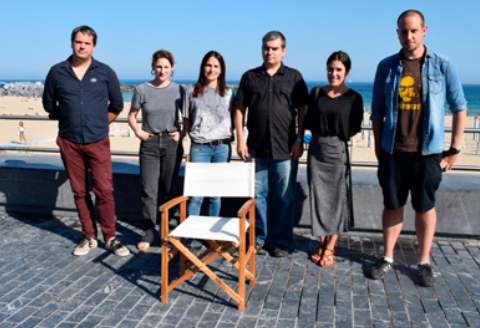It was the 59th edition of the San Sebastian Film Festival, September 20, 2011. Journalists and accredited critics were able to watch the same day two films in Basque: Telmo Esnal ‘Happy New Year, Grandma’ and Imanol Rayo ‘Bi anai’. Euskadi Irratia had an issue to make the Festival known. But there wasn"t a television show that reported those two releases. Most viewers went to bed without knowing that the same day two Basque films premiered in San Sebastian.
From the 60 edition this was not going to happen. In 2012, the idea of a daily television program at the Film Festival emerged in the newspaper Berria. The natural comrade was Hamaika. Once immediately accepted Berria’s proposal and that year they carried out the program ‘Zinemaldi@n’ between newspaper and television. The challenge was not easy: Run a one-hour live programme every day the festival lasted. The director of the program was Lara Madinabeitia BERRIA. Remember the bet: “At that time, live online broadcasts were not as common as they were now. For example, Youtube did not offer normal users the possibility to do direct. We decided to use the Ustream platform. We started with a laptop, a webcam and a conventional camera.” Berria’s website broadcast the program live. And with a little editing, the Once went through the night.
Inaxio Esnaola, journalist of Irutxulo, was the host of the program for five years. In his image, the new television show filled a gap. “The Basque public chain has no film program, and the continuity of ETB 1 to Zinemaldia is not differentiated. It is surprising that, in collaboration with the Berria newspaper, a small private television is responsible for drawing up a programme on the Film Festival. Furthermore, from Kursaal’. Thus: The members of the Zurriola armchair program have placed the plató in a corner of the San Sebastian Film Festival in the lower Kursaal. And Berria and Once were clear about the goal: Publicize the festival in Basque, but with special attention to Basque productions. At the same time, the TV program became a meeting point for Basque critics who were watching the films released at the Zinemaldia. In each episode it was a tertulia with two critics.
New comrades
In 2013, in the second year, the program adopted the new name of Zurriola armchair, the definitive one. It was introduced that year by journalist Gorka Erostarbe, who made ingenious and juicy presentations at the beginning of each episode. The program team realized that a journalist from Irutxuloko Hitza was making videos that offered other views of the Festival. After asking the journalist Lide Ferreira for permission, Hitza"s videos began to enter the television show. This allowed Berria and Once to make a proposal to the local environment of Donostia: to participate formally in the production of the program. Esnaola believes that the projection of Irutxulo videos in the television program has advantages: “Provides visibility, dissemination and brand positioning. It is important for Irutxuloko Hitza to participate in the program to show what works at the Film Festival.”
In 2014 there were three producers of butaka from Zurriola: Hamaika, Berria and Irutxuloko Hitza. The relationship with some critics participating in the program was being consolidated. Some highlighted the value of the session. One of them was Aitor Abaroa, then director of Gaztezlou. Zurriolako butaka invited the journalists of Gaztezutxo to participate in the session the following year, and in the 2015 edition, Abaroa and Leire Palacios themselves began to make video reviews of Basque productions. Gaztezulo became the fourth travel companion.

By then the portal in Basque Zinea was already underway. And as he did with many other contents in Basque, Zinea disseminated interviews, videos and reports of the Zurriola armchair program on social networks. The portal naturally joined the program dynamics. In fact, the videos made by Zinea had a good showcase in Zurriola butaka. The fifth travel partner officially joined the program in 2016.
The presenter of Hamaika Telebista, Anabel Arraiza, collects the witness of Inaxio Esnaola at the party. According to Arraiza, cooperation can lead to many good things: ‘The nature and situation of each media makes it necessary to cooperate in producing such a programme. We have shown that everyone can do small and big things. Cooperation between the media should remain a channel for the creation of new projects."
Kanaldude Telebista in Baja Navarra was the last means of communication that joined the collaboration of Zurriola, in the armchair space, in the place of celebration. Juana Duhalde has been part of the work team over the past two years and mentioned Kanaldude"s bet: “It was interesting for us to be present at the most important film festival in Euskal Herria. On the other hand, cooperation between the Basque media is always interesting: the build-up of forces is important to carry such a project.’
During the first six years, the program was broadcast live on the Internet. on the p, the team decided to record the session and then edit it as correctly as possible. BERRIA Madinabeitia explains the reasons: “Technically, live broadcast was very risky, especially by our thick media. Streaming connected us a lot, we couldn"t offer the desired image quality. Moreover, no changes could be made to the scales and the ability to cope with unforeseen events was diminished by the direct". Madinabeitia considers its inclusion in the Kanaldude project a step forward: ‘in the case of Kanaldude, he joined the project together with his technical and human resources’. The BERRIA video player and filmmaker believes the program improved. Duhalde also praises the partnership: “It professionally creates new networks and increases the connections between the media. In addition, the session improves year after year’.
In addition, according to Arraiza, the contribution of Zurriola butaka is important: “The Zurriola armchair is a space where every day they approach the world of film, filmmakers and Basque fans: light, close and rich. A place where, in addition to informing the Basque creators of their works, they can speak freely’.

In 2019, Zurriolako butaka celebrates its eighth year. For the same purpose in the first year: Report on the festival in Basque, give voice to professionals of Basque film and gather opinions about the films. The change has been to increase collaboration, where two were now seven. Six media in Basque and Basque film enthusiasts. Without the latter, it would be useless to perform such tests.


